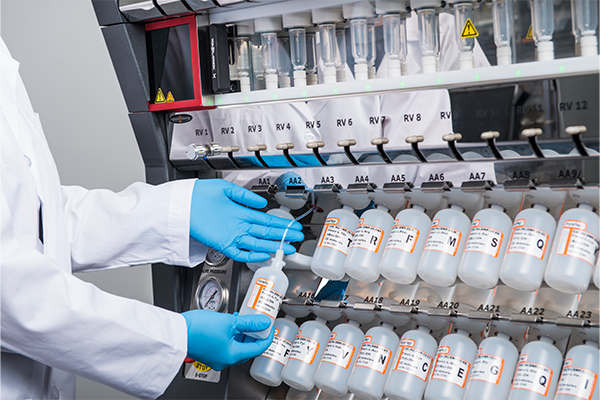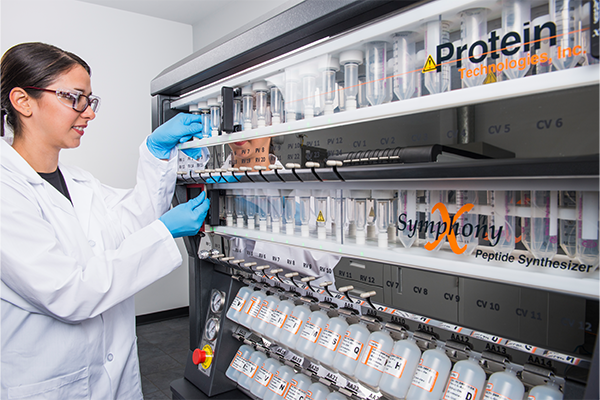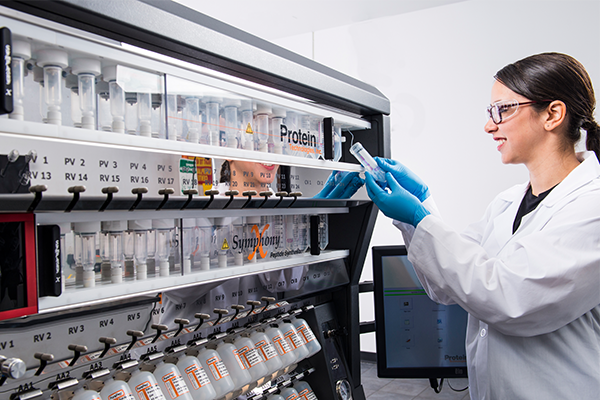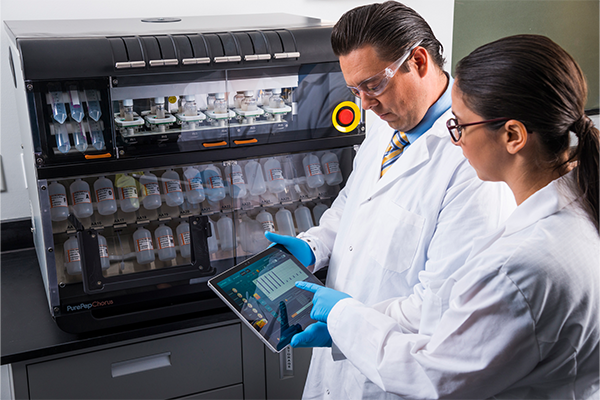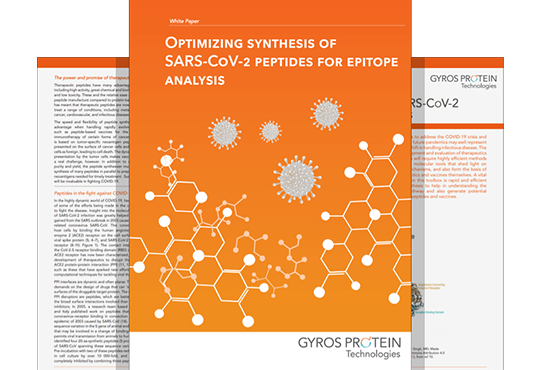Purity is key
Progress in peptide-based academic research, and the development of therapeutics and vaccines relies on the optimization of SPPS. If every single step went to 100% completion, then only the full-length peptide would be produced. This is very rarely the case, however well a protocol is optimized. Side reactions and incomplete reactions even at a low level can soon result in low yield of the required product in a background of failed sequences and the resulting poor peptide purity that can affect the application.
For example, the theoretical yield of a 70-mer peptide can be calculated as follows:
- 97% yield at every step (deprotection and coupling) gives 0.97140 = 1.4% overall yield
Increasing the efficiency towards 100% has dramatic effects:
- 99% yield: 0.99140 = 24% overall yield
- 99.5% yield: 0.995140 = 50% overall yield
Purity to match your application
The first thing to do is to decide what level of purity you require, or rather, what impurities may affect your application, e.g.:
Interference with target-binding
- Deletion sequences
- Truncation sequences
- Incompletely deprotected sequences
- Sequences modified during cleavage (reattachment of protecting groups at other locations on the peptide)
- Other side-reaction products that are formed during synthesis (e.g. aspartimide formation, oxidation products)
Interference in cell-based assays
- TFA (trifluoroacetic acid) – can kill cells used in a bioassay
- Acetic acid
Avoiding these issues can require optimization or a look at downstream processing steps, such as including a salt exchange step. You may also need to examine the relative merits of freeze-dried vs. maintaining the peptide in solution, including stability testing.
A brief guide to purity goals
With this in mind, there are general guidelines to the purity you can aim at for a particular application:
- Crude (>50% or >70%). For high-throughput screening of lead compounds. >70% for an antigen when studying immune response, although specific contaminants may need to be removed.
- Medium purity (>70% or >80%). For the production, purification and testing of antibodies used in immunoassays, enzyme substrate studies, epitope mapping, affinity purification, bioassays or other immunological applications, and peptide screening.
- Medium purity >85%. For biochemistry and semi-quantitative applications, such as enzymology, epitope mapping, or studying biological activity, enzyme-substrate interactions, or phosphorylation, and also peptide blocking in Western blotting and cell attachment.
- High purity: >90% to >98% purity. For quantitative bioassays, quantitative in vitro receptor-ligand interaction studies, biological activity with ligand binding studies, quantitative blocking and competitive inhibition assays, quantitative phosphorylation and proteolysis studies, electrophoresis markers and chromatography standards.
- Extremely high purity: >98% purity. For in vivo studies, clinical trials, or drug studies that use peptides as pharmaceuticals, and structure-activity relationship studies. Protein structure analysis by nuclear magnetic resonance studies or crystallography.
How to optimize synthesis towards your required purity
Achieving the purity you need means optimizing the efficiency of correct coupling and reducing side reactions, deletions, racemization etc. to an acceptable level. This can involve addressing sequence-specific issues presented by, for example, long peptides (>30 amino acids), local sequences that cause aggregation, or complex peptides that include hydrophobic amino acids or modifications such as cyclic, or branched residues.
Optimization involves:
- Sequence analysis, for example using software, to determine if there are regions that might present particular challenges in synthesis.
- Assessing the risk for side reactions, such as racemization. Additional steps can reduce the risk of side reactions or help increase the efficiency of individual couplings, including pseudoprolines, dipeptide building blocks, additives, and alternative sidechain protection.
- Method screening and optimization that includes key aspects of SPPS:
- Resin selection – SPPS is normally conducted on polystyrene crosslinked with 1% divinylbenzene (DVB). Alternatives include polyethylene glycol (PEG) derivatives, and the choice of core can affect synthesis success and crude purity. Linkers attached to the bead provide a reversible linkage between the growing peptide and the solid phase support and determine the properties of the final product and the chemistry that can be used. The choice of linker determines the C-terminal functional group in the final product.
- Coupling chemistry – Choice is generally dependent on the synthesis speed, with faster synthesis requiring more highly reactive (= unstable) coupling reagents (HCTU, HATU and COMU) than slower synthesis (DIC, HBTU). Reaction temperature can affect the choice of coupling chemistry.
- Reaction temperature – Increasing the temperature may speed up synthesis and improve purity, but not always. Note that microwave-based heating is just heating and does not have a special effect on synthesis.
- Monitoring deprotection by real-time ultraviolet monitoring – This can be important in optimizing protocols.
- Double couplings – Difficult couplings can be handled by doubling coupling, extending the coupling time, or adding more equivalents.
- Steric hindrance – Coupling reagents must be sufficiently rapid so that sterically hindered amino acids can be incorporated.
- Capping – Permanently blocking any unreacted amino groups following a coupling reaction, or acetylating the N-terminus of a completed peptide can be useful for minimizing deletion products.
- Fresh solvents – Re-using solvents reduces purity.
Peptide synthesizers for vaccines and therapeutic peptides
Optimizing the synthesis of complex peptides depends on handling complex chemistries while minimizing cross-contamination, dead volumes, and reagent carryover. This is especially important for the synthesis of long sequences, in which even small amounts of impurities, side products, and incomplete reactions over many cycles can drastically reduce the final purity and yield of desired peptides. Aggregation, secondary structure, steric hindrance, and conformational effects can still pose challenges in synthesis, and real-time deprotection monitoring optimizes reaction times to ensure complete deprotection.
In the case of neoantigen vaccines used in cancer therapy, parallel peptide synthesis is also important to quickly generate the pool of neoantigens needed. Speed is a critical factor since timing the delivery of a vaccine can make all the difference to the outcome. Neoantigens may be further altered through posttranslational modifications (PTMs) that occur in malignant but not healthy cells and are therefore an additional source of unique antigens that are specific to the individual patient.
Choosing a peptide synthesizer that will quickly deliver peptides with the right purity
A major factor that affects how you can optimize SPPS to achieve the peptide purity you need is the choice of synthesizer. Here are a few tips to help you in your choice:
- Parallel reaction vessels to screen methods and reagents — As we have seen, optimization can involve looking at a large number of variables. The ability to run different reagent combinations in parallel will greatly speed up the optimization process.
- Deprotection monitoring — Being able to monitor the efficiency of the deprotection step during the run avoids guesswork that can lead to incomplete deprotections, deletions, and side reactions.
- Temperature control — Increasing the temperature can improve purity for some sequences. Being able to test the effect of different temperatures in parallel can boost productivity.
- Minimal cross contamination — A peptide synthesizer that provides multi-channel synthesis with no reagent or resin cross-contamination will speed up optimization and minimize the risk of resynthesis.
- No-prime single shots for rare monomers — Many of the monomers and reagents used in special chemistries can be expensive or precious, so some synthesizers offer prime-free ‘Single-Shot’ additions from any amino acid/monomer bottle position to ensure that nothing is wasted.
- Software designed for 21 CFR Part 11 compliance if peptides are being synthesized in a GxP facility.
You can find out more about designing a peptide synthesis and minimizing side reactions by downloading our recent summary of SPPS Tips for Success webinars:
- Designing a Synthesis: How to maximize the likelihood of success when developing an automated synthesis protocol for a new peptide sequence.
- Side Reactions: How to implement strategies to reduce the risk of unwanted side reactions that inevitably occur during the chemical synthesis process.
- Peptide Manufacture: A real-world example of the synthesis of 24 SARS-CoV-2 peptides with therapeutic potential, manufactured with a focus on cGMP and regulatory compliance.
